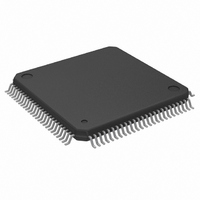HD64F7047F50V Renesas Electronics America, HD64F7047F50V Datasheet - Page 410

HD64F7047F50V
Manufacturer Part Number
HD64F7047F50V
Description
IC H8 MCU FLASH 256K 100TQFP
Manufacturer
Renesas Electronics America
Series
SuperH® SH7047r
Specifications of HD64F7047F50V
Core Processor
SH-2
Core Size
32-Bit
Speed
50MHz
Connectivity
CAN, SCI
Peripherals
POR, PWM, WDT
Number Of I /o
53
Program Memory Size
256KB (256K x 8)
Program Memory Type
FLASH
Ram Size
12K x 8
Voltage - Supply (vcc/vdd)
4.5 V ~ 5.5 V
Data Converters
A/D 16x10b
Oscillator Type
Internal
Operating Temperature
-20°C ~ 75°C
Package / Case
100-TQFP, 100-VQFP
Package
100PQFP
Family Name
SuperH
Maximum Speed
50 MHz
Operating Supply Voltage
5 V
Data Bus Width
32 Bit
Number Of Programmable I/os
53
Interface Type
CAN/SCI
On-chip Adc
16-chx10-bit
Number Of Timers
7
Lead Free Status / RoHS Status
Lead free / RoHS Compliant
Eeprom Size
-
Available stocks
Company
Part Number
Manufacturer
Quantity
Price
Company:
Part Number:
HD64F7047F50V
Manufacturer:
PANJIT
Quantity:
30 000
Company:
Part Number:
HD64F7047F50V
Manufacturer:
RENESAS
Quantity:
386
Company:
Part Number:
HD64F7047F50V
Manufacturer:
Renesas Electronics America
Quantity:
10 000
Part Number:
HD64F7047F50V
Manufacturer:
RENESAS/瑞萨
Quantity:
20 000
- Current page: 410 of 766
- Download datasheet (5Mb)
12.6
Figure 12.14 shows the general format for clocked synchronous communication. In clocked
synchronous mode, data is transmitted or received in synchronization with clock pulses. Data is
transferred in 8-bit units. In clocked synchronous serial communication, data on the transmission
line is output from one falling edge of the serial clock to the next. In clocked synchronous mode,
the SCI receives data in synchronization with the rising edge of the serial clock. After 8-bit data is
output, the transmission line holds the MSB state. In clocked synchronous mode, no parity or
multiprocessor bit is added. Inside the SCI, the transmitter and receiver are independent units,
enabling full-duplex communication by use of a common clock. Both the transmitter and the
receiver also have a double-buffered structure, so that data can be read or written during
transmission or reception, enabling continuous data transfer.
12.6.1
Either an internal clock generated by the on-chip baud rate generator or an external
synchronization clock input at the SCK pin can be selected, according to the setting of CKE1 and
CKE0 bits in SCR. When the SCI is operated on an internal clock, the serial clock is output from
the SCK pin. Eight serial clock pulses are output in the transfer of one character, and when no
transfer is performed, the clock is fixed high. Only in reception, the serial clock is continued
generating until an overrun error is occurred or the RE bit is cleared to 0. To execute reception in
one-character units, select an external clock as a clock source.
12.6.2
Before transmitting and receiving data, you should first clear the TE and RE bits in SCR to 0, then
initialize the SCI as described in a sample flowchart in figure 12.15. When the operating mode,
transfer format, etc., is changed, the TE and RE bits must be cleared to 0 before making the
change using the following procedure. When the TE bit is cleared to 0, the TDRE flag is set to 1.
Note that clearing the RE bit to 0 does not initialize the RDRF, PER, FER, and ORER flags, or the
contents of RDR.
Rev. 2.00, 09/04, page 368 of 720
Figure 12.14 Data Format in Clocked Synchronous Communication (For LSB-First)
Synchronization
clock
Serial data
Note: * High except in continuous transfer
Operation in Clocked Synchronous Mode
Clock
SCI initialization (Clocked Synchronous mode)
Don’t care
*
LSB
Bit 0
One unit of transfer data (character or frame)
Bit 1
Bit 2
Bit 3
Bit 4
Bit 5
Bit 6
MSB
Bit 7
Don’t care
*
Related parts for HD64F7047F50V
Image
Part Number
Description
Manufacturer
Datasheet
Request
R

Part Number:
Description:
KIT STARTER FOR M16C/29
Manufacturer:
Renesas Electronics America
Datasheet:

Part Number:
Description:
KIT STARTER FOR R8C/2D
Manufacturer:
Renesas Electronics America
Datasheet:

Part Number:
Description:
R0K33062P STARTER KIT
Manufacturer:
Renesas Electronics America
Datasheet:

Part Number:
Description:
KIT STARTER FOR R8C/23 E8A
Manufacturer:
Renesas Electronics America
Datasheet:

Part Number:
Description:
KIT STARTER FOR R8C/25
Manufacturer:
Renesas Electronics America
Datasheet:

Part Number:
Description:
KIT STARTER H8S2456 SHARPE DSPLY
Manufacturer:
Renesas Electronics America
Datasheet:

Part Number:
Description:
KIT STARTER FOR R8C38C
Manufacturer:
Renesas Electronics America
Datasheet:

Part Number:
Description:
KIT STARTER FOR R8C35C
Manufacturer:
Renesas Electronics America
Datasheet:

Part Number:
Description:
KIT STARTER FOR R8CL3AC+LCD APPS
Manufacturer:
Renesas Electronics America
Datasheet:

Part Number:
Description:
KIT STARTER FOR RX610
Manufacturer:
Renesas Electronics America
Datasheet:

Part Number:
Description:
KIT STARTER FOR R32C/118
Manufacturer:
Renesas Electronics America
Datasheet:

Part Number:
Description:
KIT DEV RSK-R8C/26-29
Manufacturer:
Renesas Electronics America
Datasheet:

Part Number:
Description:
KIT STARTER FOR SH7124
Manufacturer:
Renesas Electronics America
Datasheet:

Part Number:
Description:
KIT STARTER FOR H8SX/1622
Manufacturer:
Renesas Electronics America
Datasheet:












